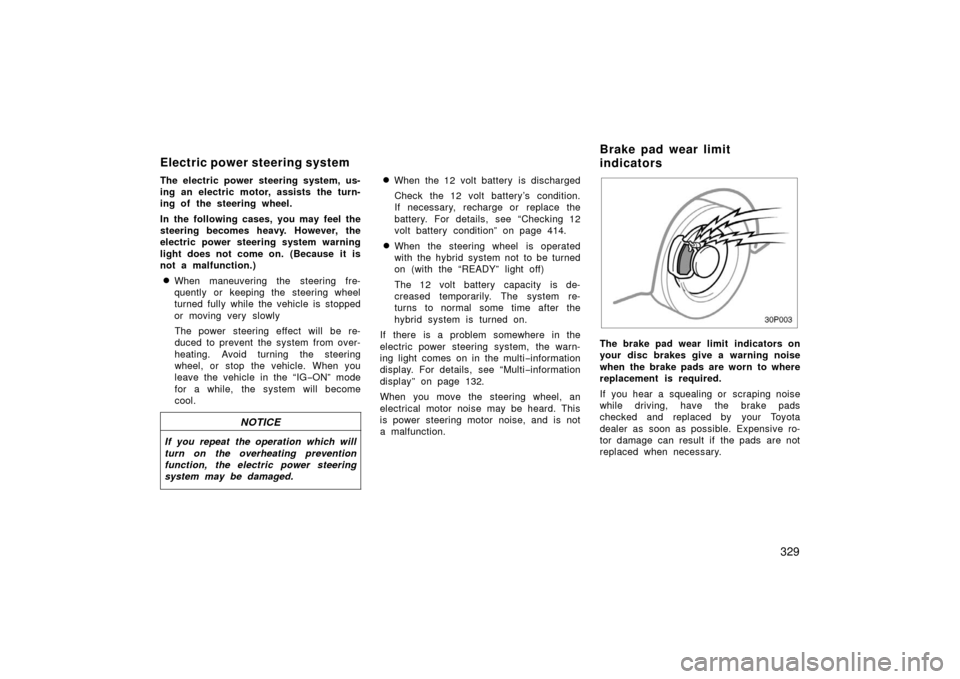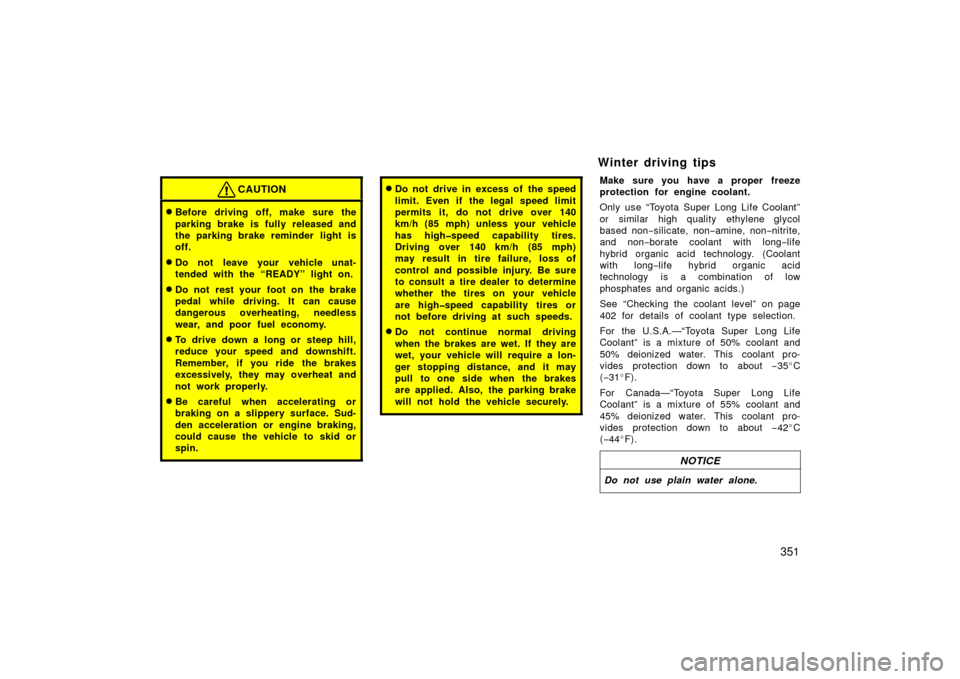Page 134 of 455

134
(a) Charging System Warning Light
When there are problems in the charging
system while the hybrid system is running,
the warning light comes on.
NOTICE
When the charging system warning
light comes on while the hybrid sys-
tem is running, malfunctions may
have occurred. If the warning light
comes on, immediately stop the ve-
hicle in a safe place and contact your
Toyota dealer.
(b) Low Engine Oil Pressure Warning Light
This light warns that the engine oil pres-
sure is too low.
If it stays on while you are driving, pull
off the road to a safe place and stop the
engine immediately. Call a Toyota dealer
or qualified repair shop for assistance.
The light may come on when the oil level
is extremely low. It is not designed to
indicate low oil level, and the oil level
must be checked using the level dipstick.
NOTICE
Do not drive the vehicle with the
warning light on—even for one block.
It may ruin the engine.
(c) High Coolant Temperature Warning Light
The light operates to warn that the hybrid
system is almost over heating.
If it comes on while you are driving, stop
the vehicle and check your hybrid system.
For detailed instructions, see “If your ve-
hicle overheats” on page 360.
Your vehicle may overheat during severe
operating conditions, such as:
�Driving up a long hill on a hot day.
�Reducing speed or stopping after high
speed driving.
NOTICE
� Do not remove the thermostat in
the cooling system as this may
cause the hybrid system to over-
heat. The thermostat is designed to
control the flow of coolant to keep
the temperature of the hybrid sys-
tem within the specified operating
range.
� Continued driving with the light on
could result in the overheating of
hybrid system.
Page 329 of 455

329
The electric power steering system, us-
ing an electric motor, assists the turn-
ing of the steering wheel.
In the following cases, you may feel the
steering becomes heavy. However, the
electric power steering system warning
light does not come on. (Because it is
not a malfunction.)
�When maneuvering the steering fre-
quently or keeping the steering wheel
turned fully while the vehicle is stopped
or moving very slowlyThe power steering effect will be re-
duced to prevent the system from over-
heating. Avoid turning the steering
wheel, or stop the vehicle. When you
leave the vehicle in the “IG −ON” mode
for a while, the system will become
cool.
NOTICE
If you repeat the operation which will
turn on the overheating prevention
function, the electric power steering
system may be damaged.
�When the 12 volt battery is discharged
Check the 12 volt battery’s condition.
If necessary, recharge or replace the
battery. For details, see “Checking 12
volt battery condition” on page 414.
�When the steering wheel is operated
with the hybrid system not to be turned
on (with the “READY” light off)
The 12 volt battery capacity is de-
creased temporarily. The system re-
turns to normal some time after the
hybrid system is turned on.
If there is a problem somewhere in the
electric power steering system, the warn-
ing light comes on in the multi −information
display. For details, see “Multi −information
display” on page 132.
When you move the steering wheel, an
electrical motor noise may be heard. This
is power steering motor noise, and is not
a malfunction.30p003
The brake pad wear limit indicators on
your disc brakes give a warning noise
when the brake pads are worn to where
replacement is required.
If you hear a squealing or scraping noise
while driving, have the brake pads
checked and replaced by your Toyota
dealer as soon as possible. Expensive ro-
tor damage can result if the pads are not
replaced when necessary.
Electric power steering system Brake pad wear limit
indicators
Page 351 of 455

351
CAUTION
�Before driving off, make sure the
parking brake is fully released and
the parking brake reminder light is
off.
�Do not leave your vehicle unat-
tended with the “READY” light on.
�Do not rest your foot on the brake
pedal while driving. It can cause
dangerous overheating, needless
wear, and poor fuel economy.
�To drive down a long or steep hill,
reduce your speed and downshift.
Remember, if you ride the brakes
excessively, they may overheat and
not work properly.
�Be careful when accelerating or
braking on a slippery surface. Sud-
den acceleration or engine braking,
could cause the vehicle to skid or
spin.
�Do not drive in excess of the speed
limit. Even if the legal speed limit
permits it, do not drive over 140
km/h (85 mph) unless your vehicle
has high�speed capability tires.
Driving over 140 km/h (85 mph)
may result in tire failure, loss of
control and possible injury. Be sure
to consult a tire dealer to determine
whether the tires on your vehicle
are high�speed capability tires or
not before driving at such speeds.
�Do not continue normal driving
when the brakes are wet. If they are
wet, your vehicle will require a lon-
ger stopping distance, and it may
pull to one side when the brakes
are applied. Also, the parking brake
will not hold the vehicle securely.
Make sure you have a proper freeze
protection for engine coolant.
Only use “Toyota Super Long Life Coolant”
or similar high quality ethylene glycol
based non−silicate, non −amine, non− nitrite,
and non− borate coolant with long −life
hybrid organic acid technology. (Coolant
with long −life hybrid organic acid
technology is a combination of low
phosphates and organic acids.)
See “Checking the coolant level” on page
402 for details of coolant type selection.
For the U.S.A.—“Toyota Super Long Life
Coolant” is a mixture of 50% coolant and
50% deionized water. This coolant pro-
vides protection down to about −35 �C
( − 31 �F).
For Canada—“Toyota Super Long Life
Coolant” is a mixture of 55% coolant and
45% deionized water. This coolant pro-
vides protection down to about −42 �C
( − 44 �F).
NOTICE
Do not use plain water alone.
Winter driving tips